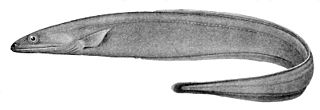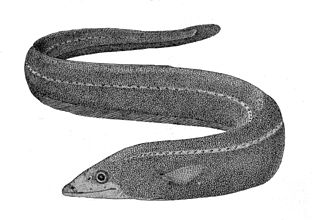
The superorder Elopomorpha contains a variety of types of fishes that range from typical silvery-colored species, such as the tarpons and ladyfishes of the Elopiformes and the bonefishes of the Albuliformes, to the long and slender, smooth-bodied eels of the Anguilliformes. The one characteristic uniting this group of fishes is they all have leptocephalus larvae, which are unique to the Elopomorpha. No other fishes have this type of larvae.

Cutthroat eels are a family, Synaphobranchidae, of eels, the only members of the suborder Synaphobranchoidei. They are found worldwide in temperate and tropical seas.

The grey cutthroat eel, Synaphobranchus affinis, is a cutthroat eel. It was originally described by Albert Günther in 1877. It lives a benthic lifestyle, inhabiting the continental slope and global deep waters including near Portugal, Canary Islands, Morocco, Japan, Australia, and others. It is a marine, deep water-dwelling eel which has been found at depths ranging from 300 to 2300 meters and at temperatures ranging from 3.3 - 11.3 °C. Males can grow to a length of up to 110 centimeters. It is primarily a scavenger, however it also actively hunts small fish and crustaceans.
The snubnosed eel, Simenchelys parasitica, also known as the pug-nosed eel, slime eel, or snub-nose parasitic eel, is a species of deep-sea eel and the only member of its genus. Some authors classify it as the sole member of the subfamily Simenchelyinae of the family Synaphobranchidae, or cutthroat eels, while others place it in its own monotypic family, the Simenchelyidae. It is found in the Atlantic and Pacific Oceans, typically at a depth of 500–1,800 m (1,600–5,900 ft) near the bottom. Although typically a scavenger, it is better known for using its powerful jaws and teeth to burrow into larger fishes as a parasite. This species is harmless to humans and of no interest to fisheries. The generic name Simenchelys translates literally as "pug-nosed eel".

Synaphobranchus is a genus of eels in the cutthroat eel family, Synaphobranchidae. It currently contains the following species:

Ilyophis is a genus of marine ray-finned fishes belonging to the family Synaphobranchidae, the cutthroat eels. These eels are found in the Atlantic, Indian and Pacific Oceans.

Histiobranchus is a genus of eels in the family Synaphobranchidae.

Eels are ray-finned fish belonging to the order Anguilliformes, which consists of eight suborders, 20 families, 164 genera, and about 1000 species. Eels undergo considerable development from the early larval stage to the eventual adult stage and are usually predators.
Atractodenchelys is a genus of eels in the cutthroat eel family, Synaphobranchidae.

Dysomma is a genus of marine ray-finned fishes belonging to the family Synaphobranchidae, the cutthroat eels. These eels are found in the Atlantic, Indian and Pacific Oceans.

Dysommina is a genus of marine ray-finned fishes belonging to the family Synaphobranchidae, the cutthroat eels. These eels are known from the Atlantic and Pacific Oceans.
Linkenchelys is a monospecific genus marine ray-finned fish belonging to the family Synaphobranchidae, the cutthroat eels. The only species in the genus is Linkenelchys multipora which is only known from around the Bahamas at around 228 m (748 ft).
Thermobiotes is a monospecific genus marine ray-finned fish belonging to the family Synaphobranchidae, the cutthroat eels. Its only species is Thermobiotes mytilogeiton which is a species of deep-water eel and is so far known only from the Vai Lili hydrothermal vent area in the western central Pacific Ocean at a depth of 1,750 m (5,740 ft).
Atractodenchelys phrix, known under the common name "arrowtooth eel" is an eel in the family Synaphobranchidae. It was described by Catherine H. Robins and Charles Richard Robins in 1970. It is a marine, deep water-dwelling eel which is known from its type locality in the eastern Caribbean, in the western central Atlantic Ocean. It is known to dwell at a depth range of 385–425 metres.
Dysomma goslinei is an eel in the family Synaphobranchidae. It was described by Catherine H. Robins and Charles Richard Robins in 1976. It is a tropical, marine eel which is known from the Indo-Pacific. Males can reach a maximum total length of 19.7 centimetres.
Ilyophis blachei is an eel in the family Synaphobranchidae. It was described by Luiz Vieria Caldas Saldanha and Nigel Merrett in 1982. It is a marine, deep water-dwelling eel which is known from the northeastern and southeastern Atlantic and southern Indian Ocean. It dwells at a depth range 580 to 2,070 metres, and inhabits the continental shelf. Males can reach a maximum total length of 79.2 centimetres (31.2 in).
Meadia roseni is an eel in the family Synaphobranchidae. It was described by Michael Hin-Kiu Mok, Chi-Ying Lee, and Hung-Jung Chan in 1991. It is a marine, deep water-dwelling eel which is known from Taiwan, in the northwestern Pacific Ocean. It is known to dwell at a depth of 1,020 metres (3,350 ft). Males can reach a maximum total length of 74.5 centimetres (29.3 in).

The shortdorsal cutthroat eel is an eel in the family Synaphobranchidae. It was described by Albert Günther in 1887. It is a marine, deep water-dwelling eel which is known from the Indo-Pacific and western central Atlantic Ocean, including Zanzibar, Maldives, Australia, Japan, Suriname, and the Gulf of Mexico. It dwells at a depth range of 900 to 3,000 metres, most often between 1,000 to 2,500 metres, and leads a benthic lifestyle, inhabiting the continental slope. Males can reach a maximum total length of 111 centimetres (44 in).

The Kaup's arrowtooth eel is an eel in the family Synaphobranchidae. It was described by James Yate Johnson in 1862. It is a marine, deep water-dwelling eel which is known from the Indo-Western Pacific and eastern and western Atlantic Ocean, including the Faroe Islands, Iceland, Cape Verde, the Western Sahara, Nigeria, Namibia, South Africa, Greenland, France, Saint Pierre and Miquelon, the United Kingdom, Ireland, the Philippines, Portugal, Spain, the Bahamas, Brazil, Canada, Cuba, Japan, Australia, Mauritania, Morocco, and Hawaii. It dwells at a depth range of 120 to 4,800 metres, most often between 400 and 2,200 metres, and inhabits the upper abyssal zone on the continental slope. It is intolerant of the temperatures of higher waters. Males can reach a maximum total length of 100 centimetres (39 in).

Ilyophinae, the arrowtooth ells or mustard eels, is a subfamily of marine ray-finned fishes belongiing to the family Synaphobranchidae, the cutthroat eels. Within its family this subfamily shows greatest number of species and the greatest morphological diversity.








